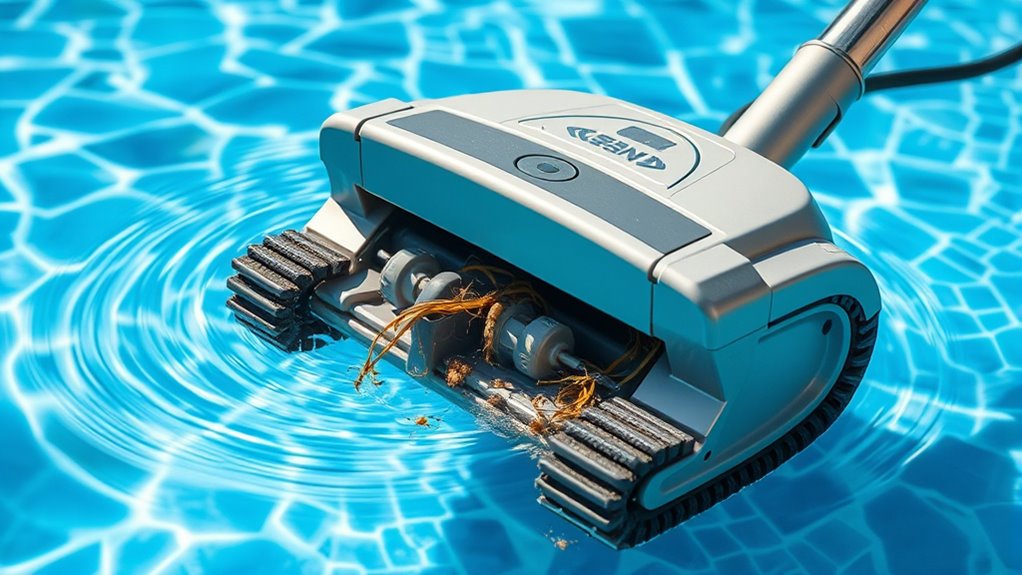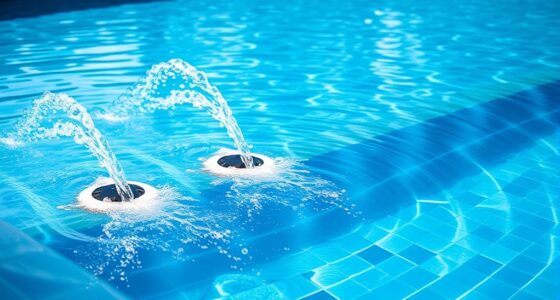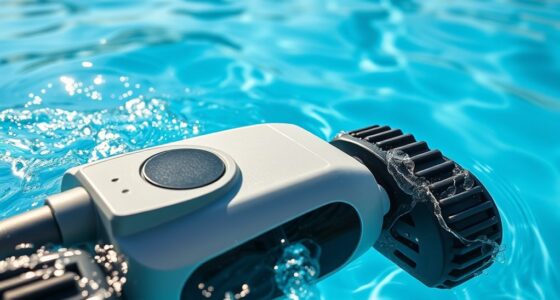If your automatic pool cleaner starts performing poorly, shows signs of wear, or experiences frequent breakdowns, it’s likely time for a replacement. Watch for declining cleaning results, excessive repairs, or higher energy bills, which indicate aging or outdated parts. Persistent blockages and damaged components also signal you should consider upgrading. If your cleaner is several years old or no longer keeps your pool as clean as it used to, there’s more to explore below.
Key Takeaways
- Declining cleaning performance and visible wear indicate it’s time for replacement.
- Frequent mechanical failures or damaged components signal the end of the cleaner’s lifespan.
- Rising repair costs and increasing energy bills suggest upgrading to a more efficient model.
- Outdated technology features and poor navigation reduce cleaning effectiveness and usability.
- Persistent blockages, clogs, or age-related decline point to the need for a new automatic pool cleaner.
Declining Cleaning Performance

If your pool cleaner isn’t cleaning as effectively as it used to, it’s a clear sign that it might be time to replace it. Over time, debris and mineral buildup can hinder performance, even with regular maintenance routines. Before replacing, check that your cleaner is properly stored; using suitable storage solutions prevents damage and extends its lifespan. If cleaning efficiency continues to decline despite routine upkeep, it indicates wear and tear that can’t be fixed through simple maintenance. A decline in performance may also point to internal parts becoming worn or damaged. Additionally, the increased presence of debris in your pool can signal that your cleaner’s automation capabilities are no longer sufficient. Don’t ignore persistent issues, as they can lead to more costly repairs or reduced water quality. Recognizing these signs early helps you decide when replacing your cleaner is the best option. Regular performance assessments can help detect early signs of decline and prevent complete failure. Monitoring wear and tear can also help determine the optimal time for replacement before major breakdowns occur.
Frequent Mechanical Failures
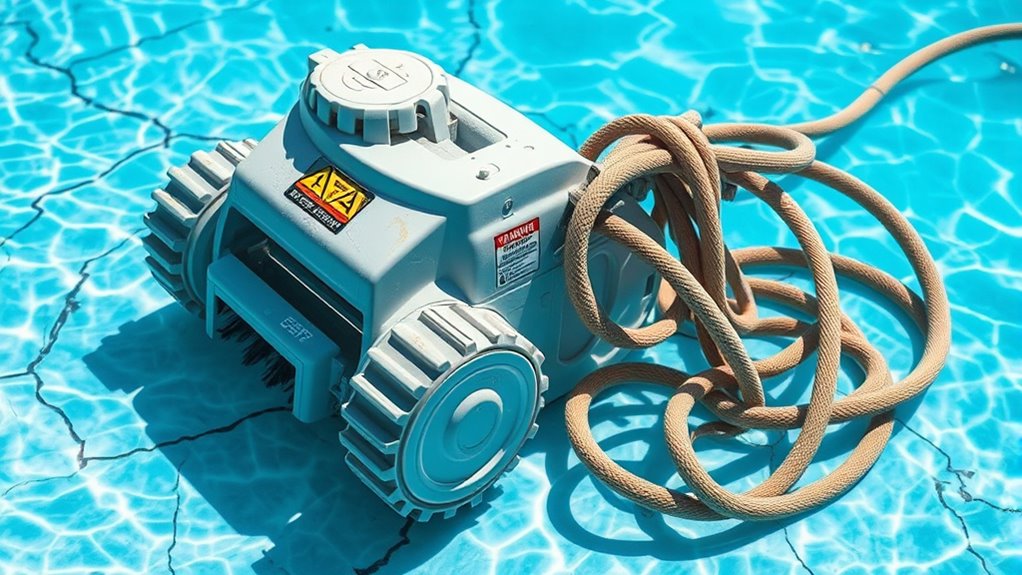
Frequent mechanical failures are a strong indicator that your pool cleaner may be nearing the end of its lifespan. If you find yourself repeatedly repairing parts or experiencing breakdowns, it’s time to contemplate replacement. These issues often happen even with regular maintenance schedules and warranty coverage, highlighting deeper wear. Keep an eye out for:
- Broken or worn-out brushes and hoses
- Motors that frequently overheat or stop working
- Persistent leaks or suction problems
- Stripped gears or damaged wheels
- Electrical component failures despite warranty support
Additionally, AI-powered innovations are transforming how equipment is maintained and replaced, offering smarter diagnostics that could help identify when your cleaner is failing. If these problems keep recurring, it’s a clear sign that your cleaner is no longer efficient. Replacing it can save you money and frustration, rather than continuously patching up an aging unit. Always consider routine maintenance as part of your decision-making process to extend the lifespan of your equipment. Staying informed about appliance labs testing and reviews can also aid in making a well-informed replacement choice. Moreover, understanding the contrast ratio of your equipment can help determine if your cleaner’s visual performance is diminishing and needs upgrading. Conducting regular inspections and performance evaluations can help catch issues early before complete failure occurs. Don’t forget to review warranty coverage and maintenance history before making a decision.
Excessive Repair Costs
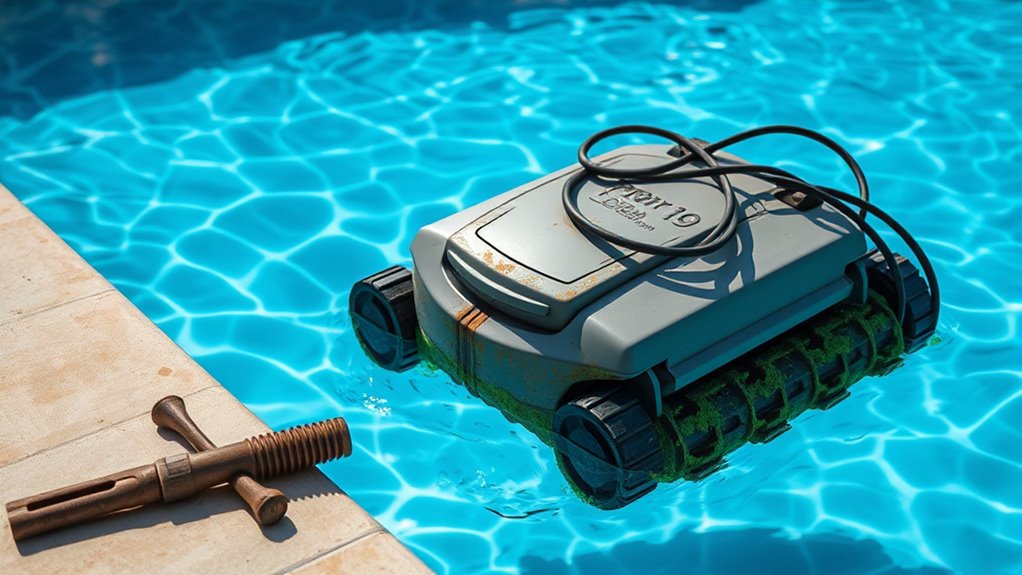
When the cost of repairs starts to outweigh the benefits of keeping your pool cleaner, it’s a sign that replacement may be more economical. Frequent repairs can add up quickly, especially if your cleaner has outdated technology or lacks innovative features that simplify maintenance. Modern, eco-friendly models often come with improved durability and energy efficiency, reducing long-term costs. If repairing your current cleaner requires replacing multiple parts or the repair bills keep climbing, it’s likely time to think about a replacement. Investing in a newer model with advanced features can save you money over time and improve cleaning performance. Additionally, regional availability of repair services can influence your decision, as limited local support might make replacement a more practical choice. Understanding long-term savings and the benefits of newer models can help you make an informed decision. Don’t let ongoing repair expenses drain your budget—sometimes, upgrading is the smarter, more cost-effective choice.
Outdated Technology Features
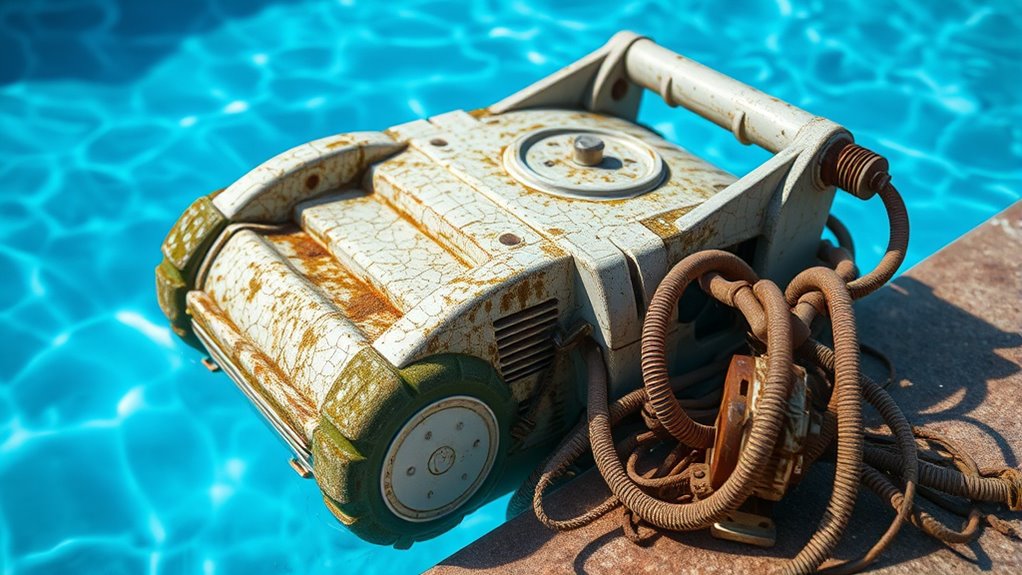
Outdated technology features can quickly make your pool cleaner less effective and more frustrating to maintain. If your cleaner lacks smart features or app integration, you’re missing out on convenience and control. Modern models often allow you to schedule cleaning, monitor progress, or adjust settings remotely—features that save time and effort. Without these updates, your cleaner may struggle with navigation or spot cleaning, leading to uneven results. Additionally, older units might not support wireless connectivity or smartphone control, making maintenance more cumbersome. Consider replacing your cleaner if it can’t keep up with current tech trends, as staying updated enhances efficiency and prolongs the device’s lifespan. Staying updated ensures your pool stays sparkling clean with minimal hassle and maximizes your investment in a device that adapts to your needs. AI in Business can optimize maintenance schedules for smarter pool management. Regularly upgrading technology ensures your equipment remains efficient and compatible with the latest innovations. Additionally, outdated devices may lack compatibility with newer smart home integrations, further limiting their usefulness.
Increasing Energy Consumption
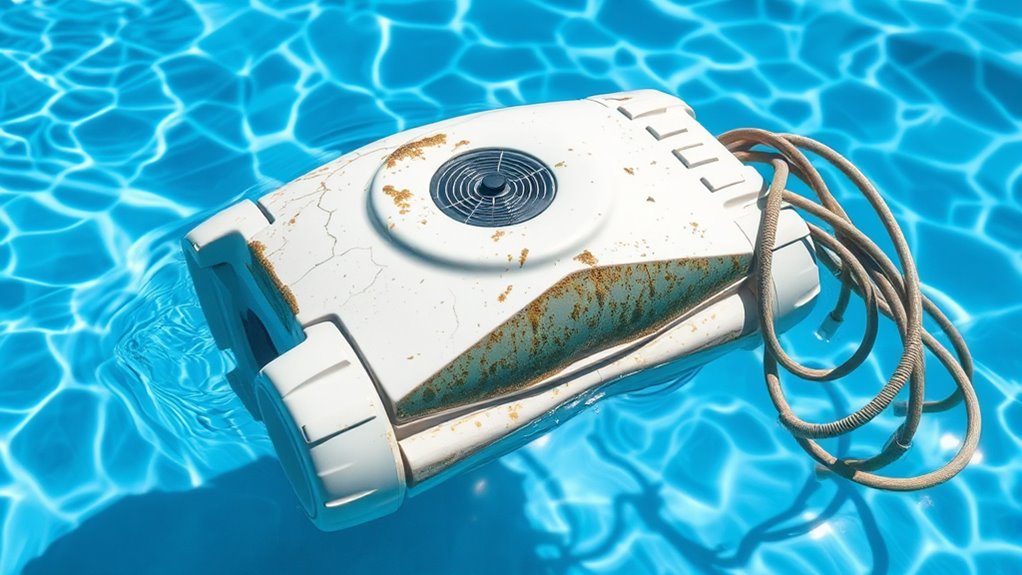
Even if your pool cleaner has the latest smart features, it can still become less efficient over time if it starts consuming more energy than necessary. Increased energy consumption not only raises your utility bills but also signals declining energy efficiency. As your cleaner ages, you might notice it running longer or struggling to perform effectively, which boosts maintenance costs too. To visualize this, consider the following:
| Age of Cleaner | Energy Use | Maintenance Costs |
|---|---|---|
| New | Low | Minimal |
| 1-2 years | Slight increase | Moderate |
| 3-4 years | Noticeable increase | Higher |
| Over 5 years | Considerably high | High |
Additionally, monitoring energy efficiency can help you decide when it’s time for an upgrade. If you notice your pool cleaner’s performance decline, it may be more cost-effective to replace it rather than continue incurring high energy and maintenance costs. Regularly assessing equipment lifespan ensures you maintain optimal operation and avoid unnecessary expenses. A decline in motor performance is also a key indicator that your cleaner might need replacing soon.
Persistent Clogging or Blockages
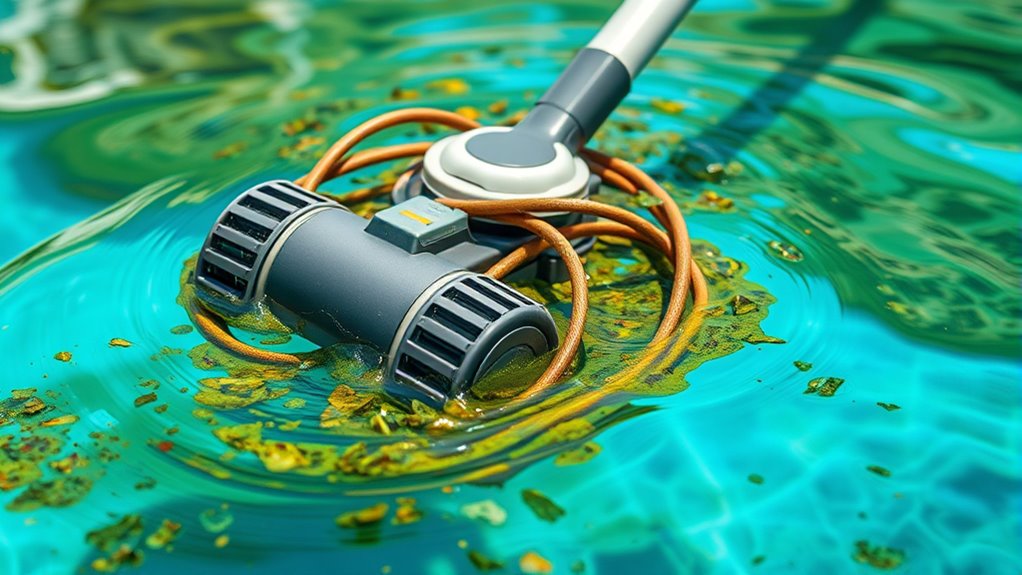
If your pool cleaner keeps getting clogged despite regular maintenance, it might be a sign it’s time for a replacement. Difficulties clearing these blockages can indicate worn-out parts or design flaws. When persistent clogging becomes a constant hassle, consider upgrading your cleaner for more reliable performance. Regularly inspecting the internal components can help identify effectiveness of eye patches, which may also be applicable when assessing the overall functionality of your pool cleaner. Additionally, understanding how Glycolic Acid benefits optimize skin health emphasizes the importance of proper maintenance and timely upgrades in ensuring efficiency and longevity. Embracing preventative maintenance techniques can further extend the lifespan of your equipment and improve overall results.
Frequent Blockages Occur
Frequent blockages are a clear sign that your pool cleaner may be nearing the end of its lifespan. When you notice it constantly gets stuck or clogged, it’s time to reassess. To reduce this issue, stick to maintenance tips and cleaning schedules, which can extend your cleaner’s life. Proper maintenance can prevent unnecessary wear and tear, but system durability also plays a crucial role in how long your cleaner remains effective. However, persistent blockages often mean replacement is inevitable. Consider these signs:
- The cleaner struggles to move smoothly
- Clogs happen even after cleaning
- You spend more time clearing debris than cleaning
- The cleaner makes unusual noises
- It requires frequent repairs
If these issues persist despite regular maintenance, it’s a good indicator that your pool cleaner has reached its limit. Regular inspections and proper upkeep help, but eventually, replacement becomes the practical choice. Additionally, quality control measures during manufacturing can influence the durability and lifespan of your pool cleaner.
Difficulties Clearing Clogs
Persistent clogs indicate that your pool cleaner is struggling to perform effectively, even after multiple attempts to clear debris. If you find yourself constantly battling blockages, it’s a sign the cleaner may be nearing the end of its lifespan. Instead of repeatedly trying to dislodge stubborn clogs, consider exploring alternative cleaning methods, such as manual scrubbing or robotic cleaners, which might handle debris more efficiently. Additionally, professional maintenance options can help diagnose underlying issues, like damaged hoses or worn-out parts, that cause persistent blockages. If these solutions don’t improve performance, it’s likely time to replace your automatic pool cleaner. Addressing clog issues promptly prevents further damage and ensures your pool stays clean with minimal hassle.
Worn Out or Damaged Components
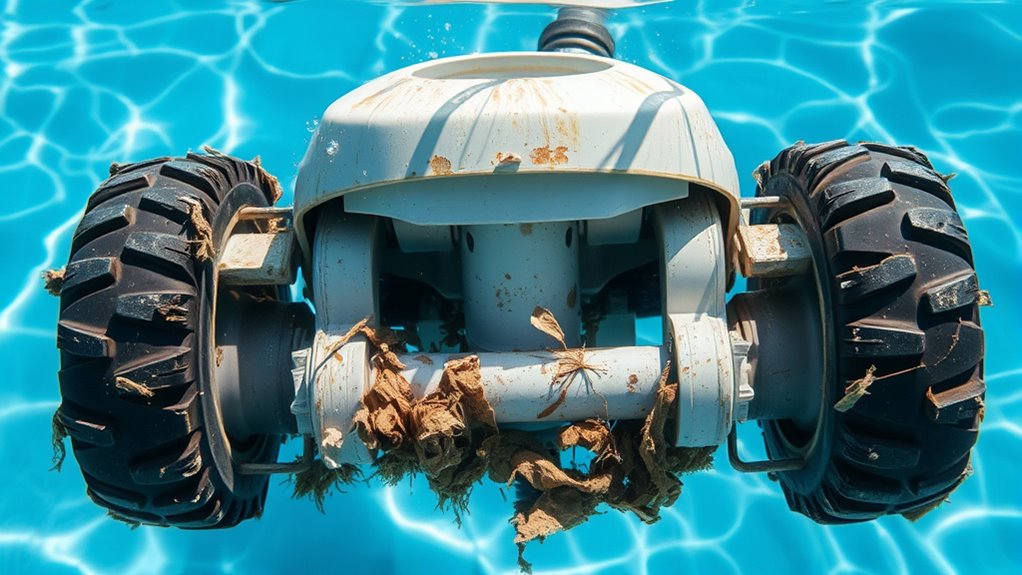
If your pool cleaner’s brushes or wheels look worn out or are not turning properly, it’s time to replace them. Cracked or leaking hoses can also cause malfunctions and reduce cleaning efficiency. Addressing these damaged components promptly keeps your cleaner working effectively.
Damaged Brushes or Wheels
Damaged brushes or wheels can considerably reduce your pool cleaner’s effectiveness, making it harder to keep your pool spotless. If you notice the cleaner isn’t scrubbing surfaces well or moving smoothly, it’s time for brush replacement or wheel maintenance. Worn brushes won’t clean thoroughly, and damaged wheels can cause erratic movement. Check for these signs:
- Bristles are frayed or missing
- Wheels are cracked, chipped, or stuck
- Movement feels sluggish or uneven
- The cleaner leaves dirt behind
- Unusual noises during operation
Replacing brushes and maintaining wheels regularly ensures superior cleaning. Don’t delay brush replacement or wheel maintenance, as neglecting these parts can lead to bigger issues and less efficient pool cleaning. Keeping these components in good shape keeps your pool spotless and extends your cleaner’s lifespan.
Cracked or Leaking Hoses
Cracked or leaking hoses can substantially impair your pool cleaner’s performance, leading to reduced suction and inefficient cleaning. Over time, the hose material, such as rubber or vinyl, may become brittle or develop tears. Inspect your hoses regularly for visible cracks or leaks. When damage occurs, repair techniques like sealing small holes with waterproof hose repair tape or replacing damaged sections are effective. For larger cracks or extensive damage, replacing the entire hose is often the best solution. Using the correct hose material during repairs ensures durability and proper fit. Addressing cracked or leaking hoses promptly prevents further damage to your pool cleaner and maintains ideal cleaning efficiency. Regular maintenance and timely replacements keep your automatic pool cleaner functioning smoothly.
Age of the Pool Cleaner
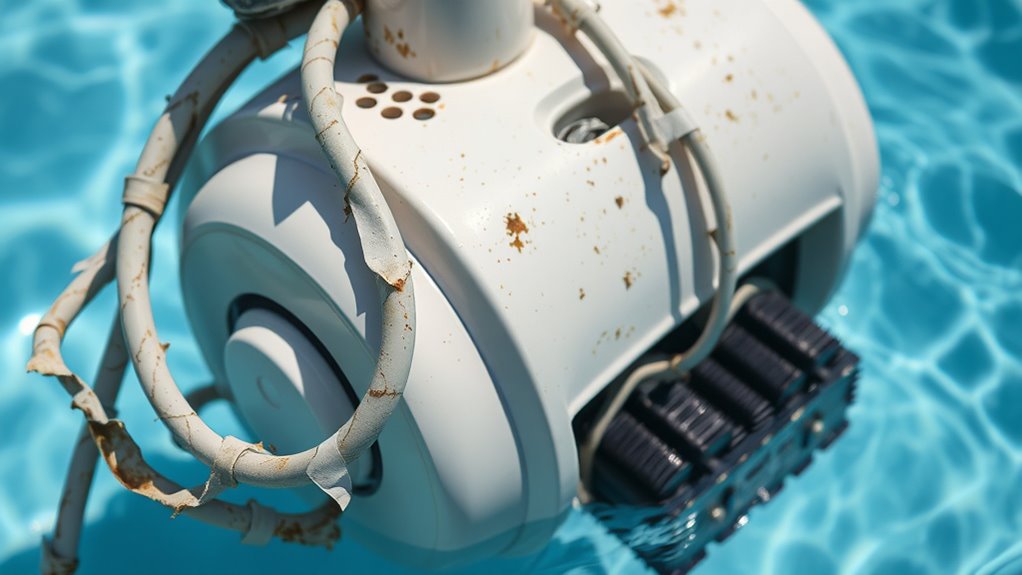
As your pool cleaner ages, its efficiency and performance tend to decline. Over time, parts wear out, making it harder to keep up with regular pool maintenance and water chemistry. You might notice it missing spots or taking longer to clean. To determine if it’s time for a replacement, consider these signs:
As your pool cleaner ages, its performance declines, signaling it’s time for a replacement.
- Frequent breakdowns or repairs
- Reduced cleaning effectiveness
- Excessive energy consumption
- Difficulty steering your pool
- Outdated technology or missing parts
An older cleaner may struggle to handle changing water chemistry, leading to algae or debris buildup. If your device is over several seasons old and showing these signs, it’s probably time to replace it for ideal pool care and maintenance. A new cleaner saves you time and keeps your pool sparkling.
Frequently Asked Questions
How Can I Tell if My Pool Cleaner Is Under Warranty?
To determine if your pool cleaner is under warranty, start with warranty verification by checking your purchase receipt or the manufacturer’s website. Look for details about replacement policies, which usually specify the warranty period and conditions. If you’re unsure, contact customer service with your model number and purchase date. Doing this helps you understand your coverage and whether repairs or replacements might be free or require a fee.
Are There Eco-Friendly Options for Replacing My Pool Cleaner?
Thinking about eco-friendly options for replacing your pool cleaner? You’ll love discovering models that prioritize sustainability with superior energy efficiency and sustainable materials. These cleaners reduce your energy bill and minimize environmental impact, making your pool maintenance more responsible. Look for eco-conscious brands that emphasize eco-friendly features. Switching to a greener cleaner helps protect the planet while keeping your pool pristine, all without sacrificing power or performance.
What Are the Safety Considerations When Disposing of an Old Cleaner?
When disposing of your old pool cleaner, prioritize safety by handling chemical disposal carefully, ensuring any leftover cleaning agents are properly contained and discarded according to local regulations. Always unplug the device before disposal to prevent electrical safety hazards, and avoid damaging electrical cords or components. Take your time to follow proper disposal procedures to protect yourself and the environment, making sure you’re compliant with safety standards.
Can I Upgrade My Current Pool Cleaner Instead of Replacing It?
Thinking of upgrading your pool cleaner is like giving your pool a fresh set of shoes. You can explore pool cleaner upgrades to boost performance, but weigh maintenance vs replacement. Upgrades might be cost-effective and extend your cleaner’s life, but sometimes replacing is the smarter choice if your current model is outdated or costly to repair. Consider your pool’s needs and your budget to decide the best route forward.
How Does the Cost of a New Cleaner Compare to Repairs?
When considering a new automatic pool cleaner, you might wonder how the cost comparison stacks up against repair expenses. Typically, a new cleaner costs more upfront, but repair expenses for your current model can add up over time. If repairs become frequent or costly, investing in a new cleaner could save you money and hassle. Ultimately, evaluate repair costs versus the price of a new, more efficient model to make the best choice.
Conclusion
When your pool cleaner’s performance drops like a setting sun, it’s time to contemplate a replacement. Don’t let worn-out parts and rising costs weigh you down like an anchor. Upgrading your cleaner is like giving your pool a gust of fresh air—more efficient and trouble-free. Recognizing the signs early keeps your pool pristine and saves you from costly repairs. Trust your instincts; sometimes, a new cleaner is the shining beacon guiding you toward a sparkling pool.
